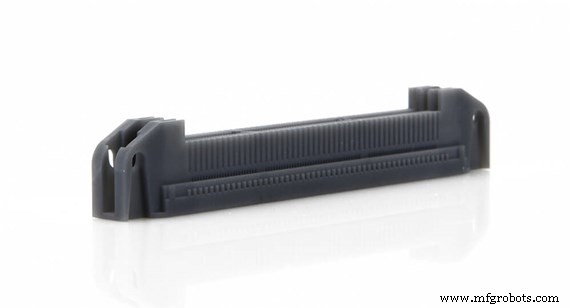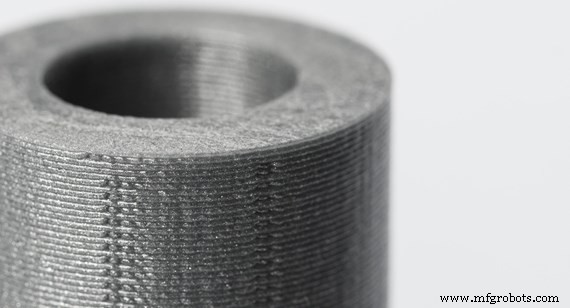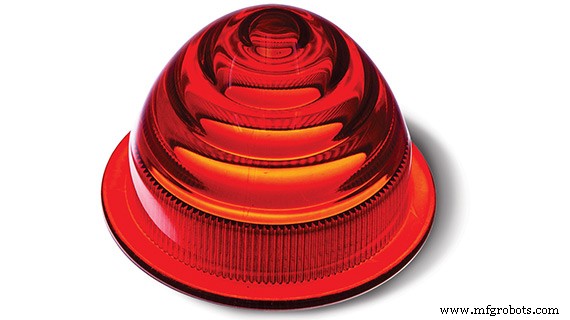SLA 대 FDM:일반적인 3D 인쇄 기술 비교
적층 제조, 특히 현대식 3D 프린팅은 1983년 처음 개발된 이후 많은 발전을 이루었습니다. 오늘날의 3D 프린팅 부품은 고해상도와 허용 오차를 달성할 수 있습니다. 보다 일반적인 두 가지 기술은 SLA(Stereolithography)와 FDM(Fused Deposition Modeling)입니다. 둘 다 1980년대에 등장했지만 부품을 만드는 방식이 뚜렷하게 다르므로 결과적으로 최종 부품은 각각 다른 이점을 제공합니다.

Protolabs의 MicroFine Gray™ 수지로 만든 SLA 부품은 초정밀 해상도를 달성합니다.
SLA는 어떻게 작동합니까?
SLA는 부품의 원료로 광수지 수지를 사용합니다. 포토폴리머는 경화되기 위해 레이저의 강렬한 자외선이 필요하며 이것이 SLA의 핵심 아이디어입니다. 빌드는 레진에 잠긴 플랫폼에서 이루어집니다. 레이저는 탱크 위에 위치하며 정밀 거울의 지시에 따라 액체 수지를 융합하여 한 번에 한 층씩 원하는 부품 모양을 얻기 위해 경화시킵니다. 지지 구조는 부품이 플랫폼에 단단히 고정되고 적절하게 지지되도록 하는 첫 번째 레이어입니다. 통과할 때마다 리코터 블레이드가 부품 위의 수지 표면 장력을 끊습니다. 그러면 부품이 아래에서 위로 구성됩니다.
FDM은 어떻게 작동합니까?
3D 프린팅의 초기 형태 중 하나인 FDM은 Stratasys의 창립자 중 한 명인 Scott Crump가 발명했습니다. 개념은 간단합니다. 열간 글루건을 사용하는 것과 비슷합니다. 열가소성 필라멘트 또는 플라스틱 스풀이 융점까지 가열됩니다. 뜨거운 액체 플라스틱이 노즐을 통해 나와 빌드 플랫폼의 X축과 Y축을 따라 얇은 단일 층을 만듭니다. 층이 빠르게 냉각되고 경화됩니다. 각 층이 완성되면 플랫폼이 낮아지고 추가 용융 플라스틱이 증착되어 부품이 수직으로(Z축을 따라) 성장합니다.
SLA 및 FDM의 재료 속성
| 프로세스 | 작동 방식 | 강도 | 마침 | 공통 자료 |
|---|
| SLA | 레이저 경화 포토폴리머 | 2,500-10,000(psi)
17.2-68.9(MPa) | 일반적인 0.002-0.006인치(0.051-0.152mm)의 추가 레이어 | ABS, PC 및 PP와 유사한 열가소성 유사 포토폴리머 |
|---|
| FDM | 융합 돌출 | 5,200-9,800(psi)
35.9-67.6(MPa) | 일반적인 0.005-0.013인치(0.127-0.330mm)의 추가 레이어 | ABS, PC, PC/ABS, PPSU, PEEK, ULTEM |
|---|
 이 FDM 부분에서 레이어 선이 보입니다. 사진:3Dhubs.com
이 FDM 부분에서 레이어 선이 보입니다. 사진:3Dhubs.com
Neither of these techniques creates parts as strong as ones that are injection molded, for example, but they are suitable for rapid prototyping. SLA’s thin layers and strong bonding between the layers makes its parts smoother, with minimal striations along the Z axis, the direction of the build.
SLA Considerations
If details and surface smoothness are important for your part, SLA handily beats FDM. In part, because of its roots in laser technology, SLA parts can offer incredibly fine detail, yet pricing is competitive. Also, the SLA ultraviolet light curing process avoids FDM’s issues caused by heat compressing previously drawn layers. Equally important, SLA offers many additional finishing options, such as dyeing and texturing.
With SLA, there are three resolution levels from which to choose, ranging from 0.004 in. (0.1016mm) to 0.001 in. (0.0254mm) for layer thickness. Choosing one over the other not only affects part quality, but manufacturing time, too. Minimum feature size can be as small as 0.0025 in. (0.0635mm) on the XY plane and 0.008 in. (0.2032mm) on the Z axis.
One important issue with SLA parts is their sensitivity to light. As photopolymers, they can degrade from exposure to UV rays, such as sunlight. Adding a protective coating can slow this process.
MicroFine™ is an exclusive Protolabs material available in gray and green. This micro-resolution, ABS-like material can print layers that are extremely thin:just 0.001 in. (0.0254mm). That kind of precision is a prerequisite for building parts with many small feature details and is regularly used for small and highly accurate medical components.
FDM Considerations
FDM uses engineering-grade materials (see chart above) and offers a range of color options. With some FDM printers, parts can be as large as 427 in. x 153 in. x 172 in. (10,845.8mm x 3,886.2mm x 4,368.8mm). Essentially it depends on the size of the build space. Also, FDM parts are moderately priced, making it ideal for hobbyists, dental offices, and classrooms.
FDM’s tolerance is dependent on how the machine is set up, but can be as small as +/-0.0035 in. (+/-0.0015mm). Layer thickness varies based on the material you’re using, and some printers can print as thin as 0.001 in. (0.0254mm), although this would lead to long print times and may not be possible with larger parts.
Because temperature affects the core material, FDM parts are subject to rippled exterior edges caused as new layers are dropped atop previous layers. These Z-axis issues also cause weakness in the build. So, a part’s strength is entirely dependent on the direction in which it was built.
FDM does not do well with wide, flat areas, and has difficulties printing sharp corners, so adding fillets to your design makes sense. For all these reasons, prototyping with FDM works well when accuracy and surface finish aren't critical.
Although FDM gets the check for cost, SLA is quite competitive, especially for cosmetic prototypes with intricate designs. It’s also a go-to process to create forms for injection molding and casting.
When to Use SLA and FDM
With all of these considerations in mind, here is a list of when to use either method.
Use SLA :
- For rapid, complex prototyping
- When precision and a smooth surface finish is important
- When high resolution, fine detail, and accuracy is necessary
- For creating molds for casting to facilitate mass production
- When strength and durability of the model is not crucial (models made from resin may suffer when exposed to the sun for long periods)
Use FDM :
- For prototyping
- When a selection of colors is needed
- For low-cost models
- When precision and surface finish aren’t crucial
- For hobbyist and maker projects

SLA produced this clear, red taillight with a smooth finish and custom post-production painting.
For additional help, feel free to contact a Protolabs applications engineer at 877-479-3680 or [email protected]. To get your next design project started today, simply upload a 3D CAD model for an interactive quote within hours.








 Protolabs의 MicroFine Gray™ 수지로 만든 SLA 부품은 초정밀 해상도를 달성합니다.
Protolabs의 MicroFine Gray™ 수지로 만든 SLA 부품은 초정밀 해상도를 달성합니다.